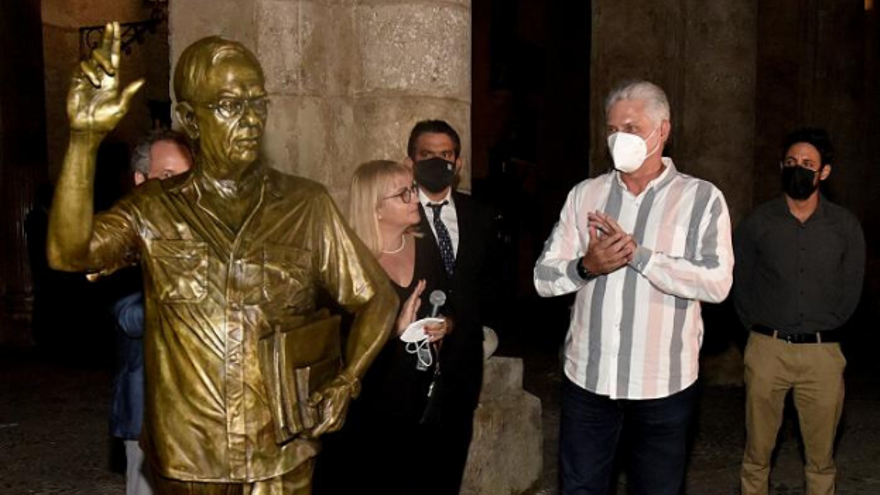
![]() 14ymedio, Xavier Carbonell, Salamanca, 2 August 2022 — The legacy of Eusebio Leal, after two years of his death, fits in a couple of showcases and some tearful speech. An exhibition at the Elvira Cape Provincial Library, in Santiago de Cuba, was the greatest tribute to which the historian of Havana could aspire, far from the city to which he dedicated his life.
14ymedio, Xavier Carbonell, Salamanca, 2 August 2022 — The legacy of Eusebio Leal, after two years of his death, fits in a couple of showcases and some tearful speech. An exhibition at the Elvira Cape Provincial Library, in Santiago de Cuba, was the greatest tribute to which the historian of Havana could aspire, far from the city to which he dedicated his life.
The Office of the Historian, dismantled in practice by the Armed Forces, exists as a symbolic skeleton to take advantage of the influence gained in life by Leal, although deprived of its business background.
Eusebio Leal died on July 31, 2020, and while the Government was preparing the funeral to embalm one of its most skilled managers, the military bureaucracy was grinding its teeth to reorganize the Office. A wave of dismissals, relocations, betrayals, departures from the country and petty battles for the favor of the new masters took hold of the most independent institution in Havana.
“They don’t have money for anything and the projects they used to have to help people in poverty were limited,” says a former worker at the Office. “It was the case of the department that was in charge of Humanitarian Affairs, from which the old people of Old Havana received help and donations. Now, they cannot even drink a glass of milk.”
The man points to Perla Rosales, deputy director of the Office and daughter of Division General Ulises Rosales del Toro, former Minister of Agriculture and one of Raúl Castro’s “incombustible” faithful, as responsible for the “surrender” to the military.
“I worked with them for many years, before the decline began,” he says. “The old directors retired or left the country, because they knew the misery that was coming: with Perla Rosales nothing can be ’resolved’, only she has ‘authorization’ to fill her pockets.”
“The residences for the elderly, very different from the asylums,” says the former worker. “They tell me that the employees, with a key to the apartments, usually enter and rob the old people with impunity. That did not happen with Leal.”
Havanans had become accustomed to a certain “activity” in the main arteries of the city. Stores, agencies, projects or museums promoted by the Office or by its economic arm, Habaguanex.
However, in 2016 the progressive dismantling of this corporation began, involving, according to rumors, an unprecedented embezzlement that the Government took advantage of to limit the functions of the Historian.
Leal himself admitted to this newspaper that many of the Office’s establishments were being transferred to Gaesa, directed by the late General Luis Alberto Rodríguez López-Calleja, a conglomerate that the historian defined as “a development company with investment capacity and prestige,” although he would retain “the power to advise on the conservation of the work and also on new projects.”
“It hurts us, yes, that at a time when perhaps the greatest respect for life circumstances is required, the mediocre ones who lack any work, and the poor in spirit, take advantage of it to hurt and harm the many who have worked over the years to save the heritage of a nation, whether in Cuba or any latitude on earth,” he added then.
Leal had forged a multinational network of influence, achieved almost exclusively personally, which was extremely useful for the Cuban government. Two years after his death, perhaps the most scandalous thing in the state management of the Office is not having already chosen a new Historian of Havana.
In addition to economic and hotel management, Eusebio Leal recovered the former academic splendor of the Office. Founded in 1938 by Emilio Roig de Leuchsenring, the first historian of Havana, the original vocation of the Office was to rescue the capital’s heritage, both the intangible and the buildings in the historic center of the city.
The opening of the Colegio San Gerónimo in the same place where the old University of Havana was located; the financing of the Cuban Academy of Language and History; the foundation of a publishing house, Ediciones Boloña, and an extraordinary magazine, Opus Habana, formed a cultural ecosystem that Havana had lost with the cultural supremacy of the Revolution.
The “glorious ruins” that the Elvira Cape Provincial Library in Santiago de Cuba exhibits in display cases of terrible taste testify to this active editorial work.
The regime, fond of funerary statues and monuments, summoned José Villa Soberón to “capture the essence” of Leal in a sculpture. A few hours before the anniversary of his death, in the portals of the Palacio de los Capitanes Generales, some tourists were taking photos next to the bronze figure, to which a prankster had placed, in his outstretched hand, a paper cup of granizada.
In an interview granted to the official journalist Randy Alonso, during the 500th anniversary of the founding of Havana, Eusebio Leal said: “I don’t aspire to anything, I don’t even aspire to what they call posterity.”
The Cuban Government, the Armed Forces and the cultural bureaucracy have enthusiastically complied with the wish of their historian.
____________
COLLABORATE WITH OUR WORK: The 14ymedio team is committed to practicing serious journalism that reflects Cuba’s reality in all its depth. Thank you for joining us on this long journey. We invite you to continue supporting us by becoming a member of 14ymedio now. Together we can continue transforming journalism in Cuba.
